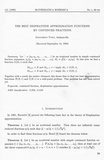Article
Full entry |
 PDF
(0.2 MB)
Feedback
PDF
(0.2 MB)
Feedback
 PDF
(0.2 MB)
Feedback
PDF
(0.2 MB)
Feedback
Keywords:
best diophantine approximation; continued fraction; diophantine approximation
best diophantine approximation; continued fraction; diophantine approximation
Summary:
Let $\xi=[a_0;a_1,a_2,\dots,a_i,\dots]$ be an irrational number in simple continued fraction expansion, $p_i/q_i=[a_0;a_1,a_2,\dots,a_i]$, $M_i=q_i^2 |\xi-p_i/q_i|$. In this note we find a function $G(R,r)$ such that
\align&M_{n+1}<R\text{ and }M_{n-1}<r\text{ imply }M_n>G(R,r),
&M_{n+1}>R\text{ and }M_{n-1}>r\text{ imply }M_n<G(R,r). \endalign
Together with a result the author obtained, this shows that to find two best approximation functions $\tilde H(R,r)$ and $\tilde L(R,r)$ is a well-posed problem. This problem has not been solved yet.
References:
[1] F. Bagemihl, J. R. McLaughlin: Generalization of some classical theorems concerning triples of consecutive convergents to simple continued fractions. J. Reine Angew. Math. 221 (1966), 146-149. MR 0183999 | Zbl 0135.11104
[2] E. Borel: Contribution a l'analyse arithmetique du continu. J. Math. Pures Appl. 9 (1903), 329-375.
[3] M. Fujiwara: Bemerkung zur Theorie der Approximation der irrationalen Zahlen durch rationale Zahlen. Tôhoku Math. J. 14 (1918), 109-115.
[4] A. Hurwitz: Über die angenäherte Darstellung der irrationalzahlen durch rationale Bruche. Math. Ann. 39 (1891), 279-284. DOI 10.1007/BF01206656 | MR 1510702
[5] W. J. LeVeque: On asymmetric approximations. Michigan Math. J. 2 (1953), 1-6. DOI 10.1307/mmj/1028989860 | MR 0062784
[6] M. Miller: Über die Approximation reeller Zahlen durch die Näherungsbruche ihres regelmässigen Kettenbruches. Arch. Math. (Basel) 6 (1955), 253-258. DOI 10.1007/BF01899402 | MR 0069850
[7] M. B. Nathanson: Approximation by continued fractions. Proc. Amer. Math. Soc. 45 (1974), 323-324. DOI 10.1090/S0002-9939-1974-0349594-X | MR 0349594 | Zbl 0293.10015
[8] O. Perron: Die Lehre von den Kettenbruchen I, II. 3rd ed. Teubner, Leipzig, 1954. MR 0064172
[9] B. Segre: Lattice points in the infinite domains and asymmetric Diophantine approximation. Duke Math. J. 12 (1945), 337-365. MR 0012096
[10] J. Tong: The conjugate property for Diophantine approximation of continued fraction. Proc. Amer. Math. Soc. 105 (1989), 535-539. DOI 10.1090/S0002-9939-1989-0937852-8 | MR 0937852
[11] J. Tong: Diophantine approximation of a single irrational number. J. Number Theory 34 (1990), 53-57. DOI 10.1016/0022-314X(90)90102-W | MR 1054557 | Zbl 0714.11036
[12] J. Tong: Diophantine approximation by continued fractions. J. Austral. Math. Soc. Ser. A 51 (1991), 324-330. DOI 10.1017/S1446788700034273 | MR 1124558 | Zbl 0739.11026

